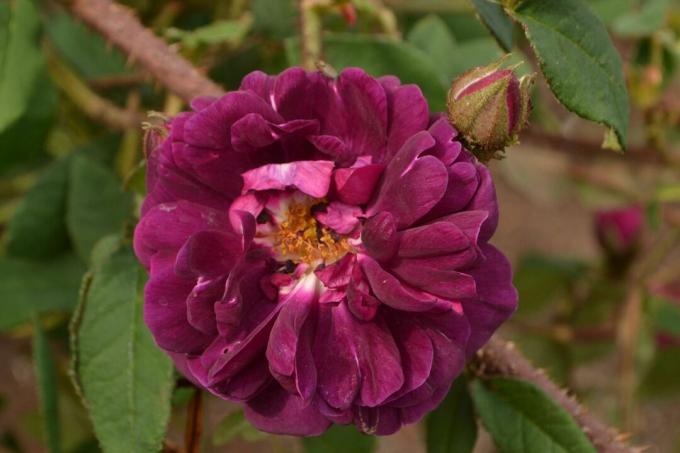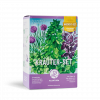The moss rose is one of the old rose varieties and is something very special. We present the most beautiful varieties and show what you should consider when planting and caring for moss roses in pots and in the garden.

The moss rose is one of the historic ones roses and has been cultivated in our gardens for a long time. Characteristic and eponymous are their moss-like glands on the infructescence, flower stalks and sepals.
contents
- Moss rose: origin and properties
- Moss rose varieties
- Planting moss roses in pot and garden
- Pruning and caring for moss roses
- Propagating moss roses
Moss rose: origin and properties
The moss rose (pink x centifolia 'Muscosa') is a European historical rose. It originated around 1700 as a mutation from various other centifolia - a group of roses with double ("hundred-petalled") flowers. The moss rose is particularly popular in cottage gardens. It grows as a strong, large shrub and reaches a height of around 1.2 m to 2 m. Its growth rate is approx. 0.7 to 1 m. Most moss rose varieties are once flowering. Between June and July, individual flowers with an intense, sweet scent bloom on their overhanging shoots. The flowers of the moss rose are hemispherical and filled. They usually appear in different shades of pink, but there are also varieties with white or purple-red flowers. The green, slightly shiny leaves of the moss rose are alternate and have an elliptical shape. The infructescence, flower stalks and sepals of the moss rose are studded with fine glands. This creates the impression of a delicate moss covering. This property gave the moss rose its name. The mossy parts of the plant have a spicy, resinous smell.

Moss rose varieties
In the course of time, new moss rose varieties were bred again and again, which differ in the color of the flowers and sometimes in the growth height. In addition to the original pink moss rose, there are also white, violet, purple or even multicolored varieties.
Popular moss rose varieties are:
'Old Pink Moss': Probably the oldest moss rose; pink, double flowers; very hardy; height: approx. 2m.
'Alfred de Dalmas': flowers white to creamy pink; intense fragrance; hardy; Height: 1-1.5m.
'Shailer's White Moss': White, densely double flowers; very strongly fragrant; very hardy; height: approx. 1.5m
′Catherine de Württemberg′: Large, very double pink to dark pink flowers; very hardy; height: approx. 1 m.
'Nuits de Young': Considered the darkest moss rose variety; black-red, double flowers; good smelling; very hardy; Height: 1-1.5m.
′Madame Moreau′: Multicolored variety with crimson pink and white striped, double flowers; fragrant; very hardy; height: approx. 1.5m

Planting moss roses in pot and garden
Moss roses prefer a sunny to semi-shady, airy location. The soil should be slightly loamy and rich in hummus. With heavy soils, some sand can be mixed in to increase permeability. On the other hand, manure or compost should be worked in on very light soils. The moss rose can also be planted in a pot on the balcony or terrace. Our peat-free is suitable for this Plantura organic potting soil optimal. In order to give the moss rose a good start into the vegetation phase, one or two fertilizer applications should be carried out in spring between March and April. You should ideally use a predominantly organic fertilizer like ours Plantura organic rose fertilizer Select. This reliably supplies your roses with all the important nutrients. Work the fertilizer lightly into the top layer of soil to increase its effectiveness. After fertilizing, you should also water extensively.
tip: Diseases and Pests in Roses are a big topic, because they destroy the splendor of the flower queen far too easily. If you want to prevent this, pay attention to good soil preparation when planting and ensure healthy and resistant roses with regular and high-quality fertilizers.
For more information and helpful expert tips on planting roses, see our dedicated article on the subject plant roses.
Pruning and caring for moss roses
If the moss rose has grown well in the garden and has established itself at its location, it only needs to be supplied with water if the drought persists. Potted moss roses, on the other hand, need to be watered more frequently because they evaporate more quickly. When watering, make sure that the foliage remains dry, otherwise the risk of fungal attack increases.
Moss roses should be cut back between March and May. Firstly, deadwood must be removed. Cut dry, frozen wood close to where it meets healthy wood, or at the base if necessary. On the other hand, thin and diseased shoots must be removed. Otherwise, they rob the healthy and stronger shoots of the power to bloom. Cut them off completely at the base of the plant or at their origin on a sturdier shoot. In addition, shoots that are too dense should be thinned out. In the case of shoots that are very close together, always remove the one that is growing weaker or growing in an unfavorable direction. In this way, the air circulation in the rose bush can be improved, so that rose diseases are prevented. In addition to the annual basic pruning, densely growing or lazy shoots can be removed at the base as required. In our special article on the subject cutting roses you can read all the important steps again in detail.

Propagating moss roses
Moss roses can be propagated in a number of ways. Through vegetative propagation, for example via cuttings, you create a "clone" whose properties correspond exactly to those of the mother plant. In the case of generative propagation via seeds, the genetic material is mixed, which means that the characteristics of the offspring can hardly be predicted. You can find out what is needed for the propagation of roses and how to proceed in our special article on the subject multiply roses.
More information about that rose plants and the caring for roses as well as the diversity of Types and varieties of roses can be found in our special articles.



